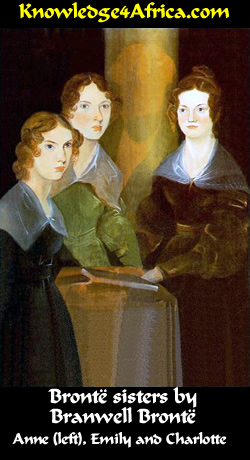|
READ THIS
This is a poem about love and loss. It is centred on the death of a loved one (or of an imaginary loved
one) some 15 years previously. The poet says she is only just getting over the death, yet she has
convinced herself that she will never feel whole again without her loved one, cannot face the empty world
without him by her side.
 A NOTE ON THE POET
A NOTE ON THE POET
Emily Brontë was born in Thornton, Yorkshire, in July 1818. She was the fourth daughter of six
children. In 1824, the family moved to the bleak village of Haworth, where Emily's father was appointed
rector of the local church.
Upon the death of her mother, Emily was sent for a time to the Clergy Daughters' School at Cowan Bridge,
a place that developed a reputation for abuse. She was removed from the school, however, when a
typhus epidemic broke out. Emily's sister, Elizabeth, would die of it -- although some commentaries
put it down to tuberculosis.
The remaining sisters and their brother Patrick Branwell Brontë would then be home-schooled by
their father and an aunt. The children created bizarre stories of adventure and fantasy for their own
amusement, and often acted them out. They also penned numerous poems.
While in her late teens, Emily was sent to the Roe Head girls' school but her life of isolation in Haworth
did not equip her to socialise. She was soon troubled by homesickness and, after only three months, she
returned to the seclusion of Haworth once more.
At the age of 20, Emily began work as a teacher in Halifax but the very long working hours -- sometimes
as much as 17 hours a day -- broke her health and she once again returned home. She now remained
with the family, while venturing out only occasionally.
In the meantime, the three sisters -- Charlotte, Emily and Anne -- had written numerous poetry. In 1847,
Emily was persuaded to publish hers as part of a volume of poetry called Poems by Currer, Ellis, and
Acton Bell.
The names "Currer, Ellis, and Acton Bell" were nom de plumes in a world where only men
published. Emily chose "Ellis Bell" as her name.
Later that same year, Emily published her one and only novel, Wuthering Heights, a bleak tale
of doomed romance set in the dark and windswept moors of Yorkshire. The book would be condemned
because of the heated passion portrayed between Heathcliff and Catherine Earnshaw.
The Brontë home was situated next to the town's graveyard and their drinking water was polluted
by the decaying bodies. It is possible that Emily's health declined steadily as a result.
She died in December 1848, although cause of death is usually given as tuberculosis. She was buried
in the family vault within the village graveyard. She was then just 30 years of age.
Have you looked at the questions
in the right column?
|
TEST YOURSELF!
Read the left column and then answer
the following questions:
"Cold in the earth -- and fifteen wild Decembers,
From those brown hills, have melted into spring."
- How old was the young poet when this person died? How do you know? (4)

[Need help?]
It is, of course, impossible to be precise. Nevertheless, the young boy had been in his grave for 15 years
when the poet penned these words. Since she herself died at the age of only 30, it means that he could
not have been any older than 15 -- and probably several years younger. Indeed, it is probable that he
was not yet even 10.
One has to bear in mind, however, that Emily Brontë had a vivid imagination, as can be seen if one
reads Wuthering Heights. It is quite possible therefore that the setting in this poem -- including
her loved one -- is the product of her imagination. He might therefore have been her imaginary lover,
in which case he could have been any age.
|
- Comment on the word "wild" in "fifteen wild Decembers". (4)

[Need help?]
"Wild" could have at least two possible meanings here. It could mean that the games they were
playing as children were wild, energetic, strangely imaginative or even without inhibition.
On the other hand, the poet could be referring to the moors where they lived and played: the dark,
gloomy, windswept hilltops of Yorkshire which is the setting for the novel Wuthering Heights and
in which the poet's village of Haworth is situated.
|
- The poet's spirit would appear to reflect the gloom of the moors. Explain how. (2)

[Need help?]
The poet dwells on the change and the suffering of her years alone without the boy. Indeed, gloom and
a pessimistic spirit appear to have encompassed Emile Brontë's entire life.
|
"Sweet Love of youth, forgive, if I forget thee,
While the world's tide is bearing me along;
Other desires and other hopes beset me,
Hopes which obscure, but cannot do thee wrong!"
- Why would the poet appear to be desperate for forgiveness? (4)

[Need help?]
The poet had lived an isolated life at Haworth, a bleak village in the midst of the moors of Yorkshire.
Friendship was therefore rare and something to be treasured. Even though the boy is now dead, he is
still her friend in her imagination. It's a friendship she treasures and she is afraid of losing it through her
forgetfulness.
|
- What is the "world's tide" that is bearing the poet along? (2)

[Need help?]
The poet is referring to all the fretful things of life: the pains and the suffering. Hers appeared to have
been a particularly fretful life, ending early when she died of tuberculosis. The sickness alone would have
impacted negatively on her.
|
- The poet dwells in this stanza on happiness. What words does she use to promote this
image? (4)

[Need help?]
Words such as "light" and "lightened up" introduce this theme of happiness. Other words
such as "heaven", "morn (morning)", "shone", "life's bliss" and "dear life"
all add to it.
|
- Yet there is a definite negative side to this image. Explain what it is. (2)

[Need help?]
Despite all the joyful things in her life, the poet still explains that her total joy lies there in the grave.
|
|



